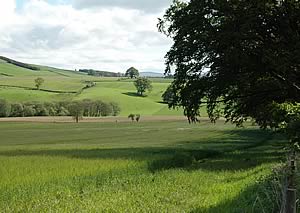| 2009-03-18
Using a five point plan could be central to giving backward winter wheat crops a much-needed boost ready for spring. That is the message to growers as they square up to making the most of some of this season’s trailing crop growth.
According to Dick Neale, technical manager for leading agronomy firm Hutchinsons, crops could be backward for a number of reasons – for example, because they were late-sown, so have had a lack of growth time, or because poor winter weather has left them suffering from waterlogged soils and poor rooting.
Either way, treat them on a field-by-field basis, he urges, with the aim of removing any constraints to help them produce optimum numbers of fertile tillers and develop root structures ready for spring growth.
“Identify what the issue is,” urges Mr Neale. Options for corrective agronomy in March can then include the following, he adds:
1. Measure where the soil nitrogen is
After the high winter rainfall, a lot of the soil’s nitrogen may have been leached beyond crops’ root zones, says Mr Neale, so it is important to establish if this is the case.
“Consider deep core testing to identify where the nitrogen is. The N-Min results coming back though our N-Planner analysis service shows many fields with low available nitrogen in the rooting zone. Growers need to know their own specific situation and allow for this to calculate accurate nitrogen applications,” he adds.
2. Apply remedial nitrogen at the earliest appropriate time
If you need to boost tiller numbers and keep them, then nitrogen is the key, says Mr Neale, so it should be applied at the earliest appropriate time.
Where soil nitrogen has been washed beyond root zones, he says growers may need to apply a larger proportion than normal of their fertiliser at an earlier time. “At least 60% of their total N should be applied by growth stage 31 to create and keep tillers,” he suggests. “And if P and K indices are also low, plants may be limited on their ability to metabolise that nitrogen and grow away – use a foliar trace element spray for rapid leaf uptake to correct this possible limitation.”
That said, if temperatures remain cold, crops could still be slow to grow away. “Speed of growth is dictated by temperature. If it’s bright and very warm you get very rapid growth. Bright light with cool temperatures and crops could still be slow.“
3. Consider a plant growth regulator
If nitrogen provides the fuel to help produce tillers, then applying a plant growth regulator (PGR), fungicide or micronutrients can help take brakes off, says Mr Neale.
“Look at an early application of plant growth regulator based on trinexapac-ethyl to benefit backward crop canopies. I’m not trying to regulate crop height at this stage - the rationale is to encourage rooting and also encourage the tiller buds to burst. This is what trinexapac-ethyl does so well and is achieved by reducing dominance of the main tiller,” he says. However, growers should check whether their PGR is suitable for applying at the same time as other inputs, he points out.
4. Reduce the disease drain
As with a PGR, an early-season fungicide can help reduce constraints on backwards crops, suggests Mr Neale, by easing the drain which diseases can exert on crop growth.
“If you want a plant to tiller you’ve got to take away the disease pressure. An early application is a bit of a tonic – removing that drain on the plant. I would consider an early spray as soon as conditions allow.”
Syngenta disease control expert Rod Burke agrees that an early fungicide could provide a useful tonic. “Small plants have only a limited green leaf area to begin with, so you don’t really want to lose that to disease,” says Mr Burke. “Photosynthesis in early leaves helps drive subsequent crop growth.
“If you’re looking for a more cost-effective fungicide in backward crops, then a low dose of triazole+chlorothalonil at T0 could fit the bill. Chlorothalonil is an excellent protectant against Septoria tritici and the triazole provides activity against S. tritici and rusts. Octolan and Cherokee (triazole+chlorothalonil combinations) have boosted yields by 0.4 t/ha from T0 use in independent trial plots. Yet they can cost less than 1% of the total of growing the crop.”
5. Check for micronutrient deficiency
Finally, consider correcting any micronutrient deficiency in backwards crops, suggests Dick Neale.
“You might get manganese deficiency if plants have small roots in cold soils. It could be a transient nutrient shortage which will be stopping tillering,” he adds.
 Pasture Renewal a Priority After Damaging Winter Pasture Renewal a Priority After Damaging Winter
 New Wynnstay Store Opens its Doors in Leominster New Wynnstay Store Opens its Doors in Leominster
 Barenbrug's Barmix Gets the Thumbs Up after Trial Barenbrug's Barmix Gets the Thumbs Up after Trial
|



